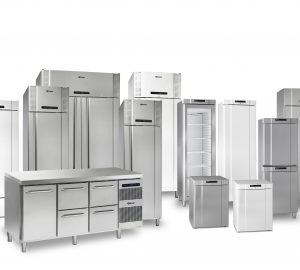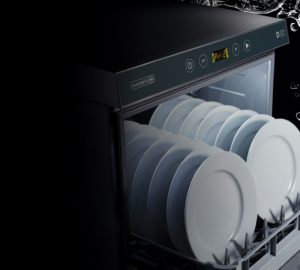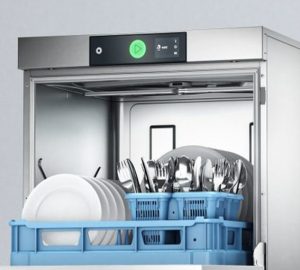Best Fire Extinguisher for a Commercial Kitchen
If you’re reading this, it’s likely that you’re a head chef, kitchen manager or restaurant owner that’s fairly new to the responsibility of kitchen safety. There are a number of different fire extinguishers out there, but only a certain type (otherwise known as Class) can be used in a commercial kitchen environment.
During this comparison guide, we’re going to provide you with all the information on the best fire extinguishers for a commercial kitchen, comparing the best use case, how to use them, their pros and cons. Let’s get to it.
Overall: What Fire Extinguisher for Commercial Cooking?
For a commercial kitchen fire extinguisher, you’ll need a Class K fire extinguisher. These are specifically designed for use in a commercial cooking environment and contain wet chemicals to combat scenariosn that are often found in a catering environment. Unlike other fire extinguishers available, Class K extinguishers contain wet chemical agents that react with the fats and oils to create a soapy substance that will suppress fires and contain them.
Commercial Class K extinguishers also offer the added bonus of the prevention of any re-ignitions.
Class K: The Best Wet Chemical Fire Extinguishers for Kitchens
So now you know that a Class K fire extinguisher is best for commercial kitchens. But how do you use them, and what are the specific pros and cons?
As we mentioned above, these types of kitchen fire extinguishers are best for suppressing cooking oils and fats as these are what cause most kitchen fires for restaurant owners and catering teams. Replacing commercial catering equipment such as large range cookers and grills isn’t cheap, so being in a position to manage and put out kitchen fires quickly is critical, which makes getting the right fire extinguisher even more important.
So what are the pros of Class K fire extinguishers for kitchens? Well, as an effective deterrent against oil and grease fires, and their ability to prevent re-ignitions, Class K fire extinguishers are also extremely safe to use on your commercial catering equipment which will minimise the risk of any expensive damages and remove the need to replace any expensive items such as commercial ovens and stoves.
As well as the ability to protect your kitchen equipment, these fire extinguishers also comply with the latest fire safety standards and regulations. Meeting the requirements in the food service industry is non-negotiable, the use of a Class K wet chemical fire extinguisher ensure you’re able to do that.
Other Fire Extinguisher Types
We’ve spent a lot of time focussing on the wet chemical fire extinguishers for use in commercial kitchens, but there are a lot of other types of fire extinguishers out there that some restaurants need to know about and when they can be used.
So let’s get into those now.
Class A Fire Extinguishers
Best for
A Class A fire extinguisher is typically used on materials such as wood and paper as well as most fabric-related fires. These aren’t suitable for cooking fires or oil fires and should not be used in the catering industry.
How to use
Like most fire extinguishers, the most effective way to use a Class A extinguisher is to secure the fire extinguisher, and point it at the base of the fire and sweep from side to side.
Pros
The benefits of Class A fire extinguishers is that they’re fairly cheap to purchase and replace once they have been used – they typically cost between £30-£70. They are also extremely effective against common combustible materials such as paper and flammable fabrics.
Cons
Class A fire extinguishers can’t be used on electrical fires, or flammable liquids. If you need an extinguisher to prevent these types of fires, you should consider a Class B and Class C extinguisher.
Class B Fire Extinguishers
Best for
Unlike Class A extinguishers, Class B fire extinguishers can be used to tackle flammable liquids and liquid-based fires. Just as with Class A, these types of fire extinguishers shouldn’t be used for kitchen fires – instead you’ll need a specialised kitchen fire extinguisher such as a Class K.
How to use
As when tackling any fire, you need to call the local fire service before attempting to put out a fire ourself. However, when tackling a Class B fire with the correct extinguisher, you should keep a safe distance, secure the fire extinguisher in your grip, pull the pin and aim at the base of the fire and execute the agent. Sweep from side to side and continue sweeping until the fire has been put out.
Pros
The main benefit of Class B extinguishers is their ability to tackle liquid-based fire emergencies. They are also fairly cheap to replace once used, priced between £40-£80.
Cons
These are not kitchen fire extinguishers and cannot be used in commercial kitchens to tackle oil or grease fires. They are also ineffective against class A and C fires if you’re trying to put out a fabric or electrical fire.
Class C Fire Extinguishers
Best for
Class C fire extinguishers are best for tackling electrical equipment and electrical fires. As with Class A and B, these are not a suitable kitchen fire extinguisher and shouldn’t be used to attempt to put out or manage a fire in a catering kitchen.
How to use
A Class C fire extinguisher, like every extinguisher will have a pin at the top that you will need to remove before you can use it. If you’re unfamiliar with how to use a fire extinguisher safely and correctly, you might want to consider a fire extinguisher training course.
Once the pin has been removed, aim the nozzle at the base and sweep from side to side until the fire is under control and has been extinguished.
Pros
The benefit of Class C fire extinguishers is their effectiveness against electrical fires and ensure that they are contained quickly and effectively, which can be the difference between saving your electrical equipment and having to replace them. Electrical catering equipment isn’t cheap, for example, replacing a fire damaged oven with a new commercial induction hob or combination microwave could cost anywhere from £1,300 up to £7,500!
Cons
As with all ABC fire extinguishers – these are not kitchen fire extinguishers and are not suitable for cooking fire and are ineffective against fabric or liquid-based fires.
Class D Fire Extinguishers
Best for
Class D extinguishers are best for tackling combustible metal fires. These could include fires that contain magnesium and titanium as an example. Unlike the ABC fire extinguishers, these are quite pricey and can cost between £200-£300 as they are highly specialist.
How to use
Using a fire extinguisher is fairly similar, regardless of whether its a Class A, B, C, D or K. You should make sure that you have assessed the fire and alerted the fire service before pulling the pin on the extinguisher and pointing it in the direction of the base of the fire.
Continue using the extinguisher and sweep from side to side consistently until the fire extinguishes. Once the fire has been put out, a professional will need to review the area to ensure there is no risk or chances of re-ignition.
Pros
These are specialist fire extinguishers designed to tackle combustable metals such as magnesium and are highly effective in these types of emergency situations and scenarios.
Cons
A Class D fire extinguisher won’t be very effective when tackling a kitchen fire. They’re not designed for commercial kitchens, electrical equipment, fabric or liquid-based fires.
Common Questions About Commercial Kitchen Extinguishers
What to do when there is a fire in a kitchen?
When tackling a kitchen fire, the first thing you need to do is assess the fire, and sound the fire alarm as this will make others aware of the emergency and could prevent other electrical appliances and catering materials such as burning oils and fats catch fire.
Once the alarm has been triggered, you need to call the fire and rescue service who will be alerted and called out to tackle and extinguish the cooking fires that have started.
If there are burning cooking oils or deep fat fryers engulfed, use a Class K kitchen fire extinguisher to manage the fire until the emergency services arrive and can take over. It goes without saying, but if there is any risk to your life or others, leave the building via the emergency fire exits and wait for help.
Don’t put yourself at risk to tackle any burning fuel or burning oil.
Can a standard extinguisher be used in a kitchen?
A key part of fire safety is understanding what types of fire extinguishers are suitable for use in catering spaces such as dealing with grease, oil and oven fires that are usually linked to an appliance.
Standard ABC and D fire extinguishers cannot be used in commercial kitchens. You will need to use Class K kitchen fire extinguishers as these are most effective against hot oils, flames and cooking oil. They have been designed to prevent the spread of fires from room to room and are commonly used on appliances such as a cooker and, or microwaves and grills.
Are Class K extinguishers required by law?
As well as fire blankets, Class K extinguishers need to be placed in cafeterias and restaurants where cooking oil is in use. This is to ensure cooking oil fires are managed correctly until the emergency services are able to attend.
How often should a Class K fire extinguisher be inspected?
You should have your dedicated fire safety marshal onsite inspect all fire blankets and extinguishers on a monthly basis. They should also be externally inspected annually by a third party and replaced or updated as needed as a matter of urgency.
Where should fire extinguishers be placed in a commercial kitchen?
There are a few key locations in a commercial kitchen that should have easy access to a fire extinguisher or blanket. This includes near cooking appliances and equipment, close to any gas or heat sources, by fire exits and on wall mounts.
It’s worth noting that as a restaurant owner, you shouldn’t think that you just require a Class K extinguisher. You should have multiple fire extinguishers in multiple locations that are suitable for tackling a variety of fires. This could include Class A for fabric or paper fires, Class B for liquid fires and Class C for electrical equipment.
You should also have fire blankets available to help extinguish smaller fires that don’t need an extinguisher activating.


